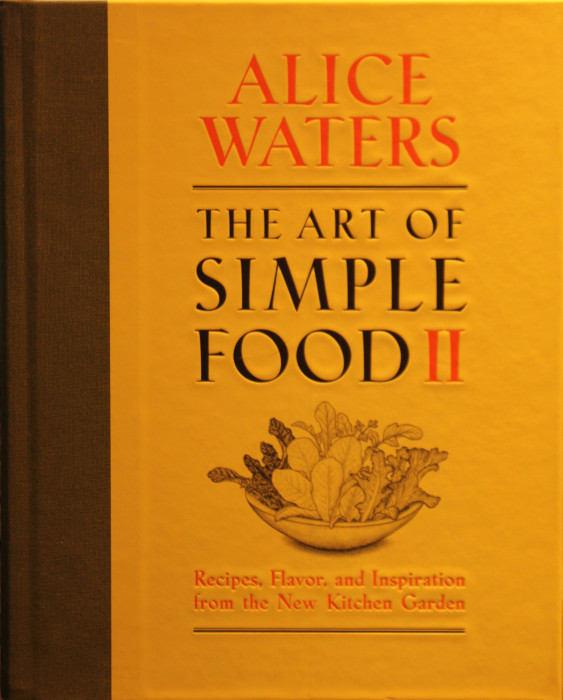Alice Waters has many claims to fame. There is the restaurant Chez Panisse. There is the long chain of food professionals who worked at Chez and then have moved on to their own great restaurants around the country. There Alice’s many books. And there is Alice’s new book: The Art of Simple Food II.
Alice’s first The Art of Simple Food published in 2007 is a serious book that truly gets to the heart of her style of food preparation — with her legendary focus on fresh, local ingredients. Today’s generation of farmers markets owes an invaluable debt to Alice’s dedicated and so persistent demand for “fresh and local.”
It would have seemed hard to surpass that first book, but The Art of Simple Food II does. To begin with, it’s a twofer, two books in one. The first 358 pages are a cookbook [and also an encyclopedia of garden products]. That first part is titled literally: Part I: Flavor as Inspiration. But then there are 55 pages in Part II: Seed to Seed. Part II is not a cookbook. It’s a gardening book. For Alice, if you have backyard or a side yard or some boxes on the porch, then “fresh and local” can have a personal meaning.
While Simple Food II does have a full spectrum of recipes, like Chicken with 40 Cloves of Garlic and Hazelnut Floating Island, every recipe here has that garden connection. There is something from the earth — vegetable or fruit or herb — that participates in each recipe. As the title of Part I indicates, those garden-based ingredients are there to inspire you, to help you create dishes that have that mysterious and wonderful extra something. That organic mystery is the trademark that Alice stamps on every recipe in the book.
There are sixteen chapters in the book organized by food type [like Ripe Summer Fruit] and simultaneously by season [Summer!]. That grouping lets you see the connections among your ingredients and how they can play and substitute for each other. Each chapter includes some genetic heritage, too. One chapter — covering cabbage, broccoli, cauliflower, kohlrabi, and Brussels sprouts — educates you that broccoli and cauliflower are actually descendants of cabbage. New species of cauliflower, for example, are being created all the time. As you might expect, Alice is at the forefront of finding, testing, tasting, and letting us all enjoy this ongoing evolution of ingredients and flavor.
What kind of recipes are here? What will intrigue you? Let’s stick with cauliflower. You’ll find Deep-Fried Romanesco Cauliflower here. And then Orange Cauliflower Salad with Fried Capers and Rocket.
Never had kohlrabi? Try the Kohlrabi, Carrot and Apple Slaw. Or the Kohlrabi and Red Lentil Dal. Yes, influences from India, from countries around the world, have penetrated the portfolio of recipes you’ll see here. There is a Tomato and Toasted Pita Bread Salad here that would be called fattoush if you were in the Middle East. You’ll enjoy Alice’s version which still calls for sumac seasoning — but thankfully offers you the option to use red wine vinegar instead. This is an example of the balance is the book, inspiration paired with practicality. The recipes are almost all less than one page with from a few to under a dozen ingredients. The book is approachable, doable, and will occupy a treasured spot on your bookshelf.
If you are a foodie, modestly or in full earnest, The Art of Simple Food II is a volume you’ll want to read, to cook from, and to share with family and friends.

